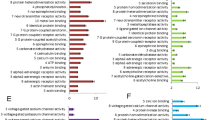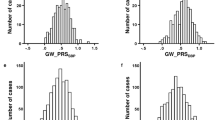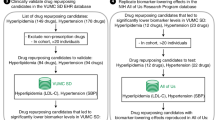Abstract
It is well known that a myriad of medications and substances can induce side effects that are related to blood pressure (BP) regulation. This study aims to investigate why certain drugs tend to cause iatrogenic hypertension (HTN) and focus on drug targets that are implicated in these conditions.
Databases and resources such as SIDER, DrugBank, and Genomatix were utilized in order to bioinformatically investigate HTN-associated drug target-genes for which HTN is a side effect. A tree-like map was created, representing interactions between 198 human genes that relate to the blood pressure system. 72 HTN indicated drugs and 160 HTN-inducing drugs were investigated. HTN-associated genes affected by these drugs were identified. HTN indicated drugs, which target nearly all branches of the interaction tree, were shown to exert an effect on most functional sub-systems of the BP regulatory system; and specifically, for the adrenergic and dopaminergic receptor pathways. High prevalence (25 genes) of shared targets between the HTN indicated and HTN-inducing drug categories was demonstrated. We focus on six drug families which are not indicated for HTN treatment, yet are reported as a major cause for blood pressure side effects. We show the molecular mechanisms that may lead to this iatrogenic effect. Such an analysis may have clinical implications that could allow for the development of tailored medicine with fewer side effects.
This is a preview of subscription content, access via your institution
Access options
Subscribe to this journal
Receive 6 print issues and online access
$259.00 per year
only $43.17 per issue
Buy this article
- Purchase on Springer Link
- Instant access to full article PDF
Prices may be subject to local taxes which are calculated during checkout

Similar content being viewed by others
References
Kunes J, Zicha J. The interaction of genetic and environmental factors in the etiology of hypertension. Physiol Res. 2009;58(Suppl 2):S33–41.
Oparil S, Zaman MA, Calhoun DA. Pathogenesis of hypertension. Ann Intern Med. 2003;139:761–76.
Handler J. Drug-induced hypertension. J Clin Hypertens. 2003;5:83–5.
de Leeuw PW. Drug-induced hypertension. Recognition and management in older patients. Drugs Aging. 1997;11:178–85.
Fournier JP, Sommet A, Durrieu G, Poutrain JC, Lapeyre-Mestre M, Montastruc JL, et al. Drug interactions between antihypertensive drugs and non-steroidal anti-inflammatory agents: a descriptive study using the French Pharmacovigilance database. Fundam Clin Pharmacol. 2014;28:230–5.
Wood AJ. Drug interactions in hypertension. Hypertension. 1988;11:II1–3.
Bitner A, Zalewski P, Klawe JJ, Newton JL. Drug interactions in Parkinson’s disease: safety of pharmacotherapy for arterial hypertension. Drugs - Real World Outcomes. 2015;2:1–12.
Go AS, Mozaffarian D, Roger VL, Benjamin EJ, Berry JD, Borden WB, et al. Heart disease and stroke statistics–2013 update: a report from the American Heart Association. Circulation. 2013;127:e6–245.
Samii A, Nutt JG, Ransom BR. Parkinson’s disease. Lancet. 2004;363:1783–93.
de Lau LM, Breteler MM. Epidemiology of Parkinson’s disease. Lancet Neurol. 2006;5:525–35.
Hajjar ER, Cafiero AC, Hanlon JT. Polypharmacy in elderly patients. Am J Geriatr Pharmacother. 2007;5:345–51.
Elliott WJ. Improving outcomes in hypertensive patients: focus on adherence and persistence with antihypertensive therapy. J Clin Hypertens. 2009;11:376–82.
Grossman A, Messerli FH, Grossman E. Drug induced hypertension - An unappreciated cause of secondary hypertension. Eur J Pharmacol. 2015;763:15–22.
Botzer A, Grossman E, Moult J, Unger R. A system view and analysis of essential hypertension. J Hypertens. 2018;36:1094–103.
Genomatix Software GmbH. Genomatix Pathway System. http://www.genomatix.de (Accessed 14 Mar 2018).
Kuhn M, Campillos M, Letunic I, Jensen LJ, Bork P. A side effect resource to capture phenotypic effects of drugs. Mol Syst Biol. 2010;6:343.
Law V, Knox C, Djoumbou Y, Jewison T, Guo AC, Liu Y, et al. DrugBank 4.0: shedding new light on drug metabolism. Nucleic Acids Res. 2014;42:D1091–7.
Padmanabhan S, Newton-Cheh C, Dominiczak AF. Genetic basis of blood pressure and hypertension. Trends Genet. 2012;28:397–408.
Chopra S, Baby C, Jacob JJ. Neuro-endocrine regulation of blood pressure. Indian J Endocrinol Metab. 2011;15(Suppl 4):S281–8.
Danzi S, Klein I. Thyroid hormone and blood pressure regulation. Curr Hypertens Rep. 2003;5:513–20.
Tisdale JE, Miller DA. American Society of Health-System Pharmacists. Drug-induced diseases: Prevention, detection, and management. 2nd edn. American Society of Health System Pharmacists: Bethesda, 2010.
Craig CR, Stitzel RE. Modern pharmacology with clinical applications. Lippincott Williams & Wilkins: Philadelphia, 2004.
Rothman RB, Baumann MH, Dersch CM, Romero DV, Rice KC, Carroll FI, et al. Amphetamine-type central nervous system stimulants release norepinephrine more potently than they release dopamine and serotonin. Synapse. 2001;39:32–41.
Weinshenker D, Schroeder JP. There and back again: a tale of norepinephrine and drug addiction. Neuropsychopharmacology. 2007;32:1433–51.
Elsworth JD, Morrow BA, Nguyen VT, Mitra J, Picciotto MR, Roth RH. Prenatal cocaine exposure enhances responsivity of locus coeruleus norepinephrine neurons: role of autoreceptors. Neuroscience. 2007;147:419–27.
Mateo Y, Pineda J, Meana JJ. Somatodendritic alpha2-adrenoceptors in the locus coeruleus are involved in the in vivo modulation of cortical noradrenaline release by the antidepressant desipramine. J Neurochem. 1998;71:790–8.
Guimarães S, Moura D. Vascular adrenoceptors: an update. Pharmacol Rev. 2001;53:319–56.
Michel MC, Brodde OE, Insel PA. Peripheral adrenergic receptors in hypertension. Hypertension. 1990;16:107–20.
Green T, Gonzalez AA, Mitchell KD, Navar LG. The complex interplay between cyclooxygenase-2 and angiotensin II in regulating kidney function. Curr Opin Nephrol Hypertens. 2012;21:7–14.
Harris RC. Interactions between COX-2 and the renin-angiotensin system in the kidney. Acta Physiol Scand. 2003;177:423–7.
Crofford LJ, Lipsky PE, Brooks P, Abramson SB, Simon LS, van de Putte LB. Basic biology and clinical application of specific cyclooxygenase-2 inhibitors. Arthritis Rheum. 2000;43:4–13.
Stichtenoth DO, Marhauer V, Tsikas D, Gutzki FM, Frölich JC. Effects of specific COX-2-inhibition on renin release and renal and systemic prostanoid synthesis in healthy volunteers. Kidney Int. 2005;68:2197–207.
Taler SJ, Textor SC, Canzanello VJ, Schwartz L. Cyclosporin-induced hypertension: incidence, pathogenesis and management. Drug Saf. 1999;20:437–49.
Cífková R, Hallen H. Cyclosporin-induced hypertension. J Hypertens. 2001;19:2283–5.
Koch CA. Endocrine hypertension: what is new? Rev Port Endocrinol Diabetes e Metab. 2012;7:52–61.
Hjemdahl P, Olsson G. Rebound phenomena following withdrawal of long-term beta-adrenoceptor blockade. Acta Med Scand Suppl. 1982;665:43–7.
Reid JL, Campbell BC, Hamilton CA. Withdrawal reactions following cessation of central alpha-adrenergic receptor agonists. Hypertension. 1984;6:II71–5.
Lewis MJ, Ross PJ, Henderson AH. Rebound effect after stopping beta-blockers. Br Med J. 1979;2:606.
Krukemyer JJ, Boudoulas H, Binkley PF, Lima JJ. Comparison of hypersensitivity to adrenergic stimulation after abrupt withdrawal of propranolol and nadolol: influence of half-life differences. Am Hear J. 1990;120:572–9.
Reid JL. Central alpha 2 receptors and the regulation of blood pressure in humans. J Cardiovasc Pharmacol. 1985;7(Suppl 8):S45–50.
Reid JL. Alpha-adrenergic receptors and blood pressure control. Am J Cardiol. 1986;57:6E–12E.
Lönnqvist PA. Alpha-2 adrenoceptor agonists as adjuncts to Peripheral Nerve Blocks in Children–is there a mechanism of action and should we use them? Paediatr Anaesth. 2012;22:421–4.
Goodman LS, Brunton LL, Chabner B, Knollmann BC. Gilman’s pharmacological basis of therapeutics. McGraw-Hill: New York, 2011.
Milazzo V, Di Stefano C. Drugs and orthostatic hypotension: evidence from literature. J Hypertens Open Access. 2012;1:1–8.
Tran TP, Panacek EA, Rhee KJ, Foulke GE. Response to dopamine vs norepinephrine in tricyclic antidepressant-induced hypotension. Acad Emerg Med. 1997;4:864–8.
Shannon M, Merola J, Lovejoy FH. Hypotension in severe tricyclic antidepressant overdose. Am J Emerg Med. 1988;6:439–42.
Iversen LL. Introduction to neuropsychopharmacology. Oxford University Press: Oxford, 2009.
Samson SL, Garber AJ. Metabolic Syndrome. Endocrinol Metab Clin North Am. 2014;43:1–23.
Warner TD, Mitchell JA. COX-2 selectivity alone does not define the cardiovascular risks associated with non-steroidal anti-inflammatory drugs. Lancet. 2008;371:270–3.
White WB. Cardiovascular effects of the cyclooxygenase inhibitors. Hypertension. 2007;49:408–18.
Messerli FH, Sichrovsky T. Does the pro-hypertensive effect of cyclooxygenase-2 inhibitors account for the increased risk in cardiovascular disease? Am J Cardiol. 2005;96:872–3.
Schnitzer TJ. Cyclooxygenase-2–specific inhibitors: are they safe? Am J Med. 2001;110:46S–49S.
DeMaria AN, Weir MR. Coxibs–beyond the GI tract: renal and cardiovascular issues. J Pain Symptom Manag. 2003;25:S41–9.
Stöllberger C, Finsterer J. Side effects of conventional nonsteroidal anti-inflammatory drugs and celecoxib: more similarities than differences. South Med J. 2004;97:209.
CKSKS Ong, Lirk P, Tan CHH, Seymour RAA. An evidence-based update on nonsteroidal anti-inflammatory drugs. Clin Med Res. 2007;5:19–34.
US Food and Drug Administration. Medication Guide for Nonsteroidal Anti-inflammatory Drugs (NSAIDs). https://www.fda.gov/downloads/Drugs/DrugSafety/ucm088646.pdf (Accessed 14 Mar 2018).
Sostres C, Gargallo CJ, Lanas A. Nonsteroidal anti-inflammatory drugs and upper and lower gastrointestinal mucosal damage. Arthritis Res Ther. 2013;15:S3.
Aljadhey H, Tu W, Hansen RA, Blalock SJ, Brater DC, Murray MD. Comparative effects of non-steroidal anti-inflammatory drugs (NSAIDs) on blood pressure in patients with hypertension. BMC Cardiovasc Disord. 2012;12:93.
Pringsheim T, Jette N, Frolkis A, Steeves TD. The prevalence of Parkinson’s disease: a systematic review and meta-analysis. Mov Disord. 2014;29:1583–90.
Connolly BS, Lang AE. Pharmacological treatment of Parkinson disease: a review. JAMA. 2014;311:1670–83.
Pavy-Le Traon A, Piedvache A, Perez-Lloret S, Calandra-Buonaura G, Cochen-De Cock V, Colosimo C, et al. New insights into orthostatic hypotension in multiple system atrophy: a European multicentre cohort study. J Neurol Neurosurg Psychiatry. 2016;87:554–61.
Palma JA, Gomez-Esteban JC, Norcliffe-Kaufmann L, Martinez J, Tijero B, Berganzo K, et al. Orthostatic hypotension in Parkinson disease: how much you fall or how low you go? Mov Disord. 2015;30:639–45.
Koller WC, Rueda MG. Mechanism of action of dopaminergic agents in Parkinson’s disease. Neurology. 1998;50:S11–4. discussion S44–8.
Fox SH. Non-dopaminergic treatments for motor control in Parkinson’s disease. Drugs. 2013;73:1405–15.
Crosby NJ, Deane K, Clarke CE. Amantadine in Parkinson’s disease. Cochrane Database Syst Rev. 2003;1:CD003468.
Heinonen EH, Myllylä V. Safety of selegiline (deprenyl) in the treatment of Parkinson’s disease. Drug Saf. 1998;19:11–22.
Douvier JJ, Vergeret J, Taytard A, Brottier E, Domblides P, Dubos F, et al. Bromocriptine in Parkinson’s disease: pleuropulmonary toxicity. Ann Med Interne. 1985;136:416–8.
Jost WH, Angersbach D. Ropinirole, a Non-Ergoline Dopamine Agonist. CNS Drug Rev. 2006;11:253–72.
Kvernmo T, Houben J, Sylte I. Receptor-binding and pharmacokinetic properties of dopaminergic agonists. Curr Top Med Chem. 2008;8:1049–67.
Eden RJ, Costall B, Domeney AM, Gerrard PA, Harvey CA, Kelly ME, et al. Preclinical pharmacology of ropinirole (SK&F 101468-A) a novel dopamine D2 agonist. Pharmacol Biochem Behav. 1991;38:147–54.
Presthus J, Hajba A. Deprenyl (selegiline) combined with levodopa and a decarboxylase inhibitor in the treatment of Parkinson’s disease. Acta Neurol Scand Suppl. 1983;95:127–33.
Lew MF, Pahwa R, Leehey M, Bertoni J, Kricorian G, Group ZSS. Safety and efficacy of newly formulated selegiline orally disintegrating tablets as an adjunct to levodopa in the management of ‘off’ episodes in patients with Parkinson’s disease. Curr Med Res Opin. 2007;23:741–50.
Dopamine Injection - FDA prescribing information, side effects and uses. https://www.drugs.com/pro/dopamine-injection.html (Accessed 14 Mar 2018).
Stahl SM. Stahl's Essential Psychopharmacology: Neuroscientific Basis and Practical Applications. 3rd ed. Cambridge University Press: New York, 2008.
Schumacher-Schuh AF, Rieder CR, Hutz MH. Parkinson’s disease pharmacogenomics: new findings and perspectives. Pharmacogenomics. 2014;15:1253–71.
Roth BL, Sheffler DJ, Kroeze WK. Magic shotguns versus magic bullets: selectively non-selective drugs for mood disorders and schizophrenia. Nat Rev Drug Discov. 2004;3:353–9.
Westerink BH. Can antipsychotic drugs be classified by their effects on a particular group of dopamine neurons in the brain? Eur J Pharmacol. 2002;455:1–18.
Becker DE. Basic and clinical pharmacology of autonomic drugs. Anesth Prog. 2012;59:159–68. quiz 169.
Sankary RM, Jones CA, Madison JM, Brown JK. Muscarinic cholinergic inhibition of cyclic AMP accumulation in airway smooth muscle. Role of a pertussis toxin-sensitive protein. Am Rev Respir Dis. 1988;138:145–50.
Yang CM, Chou SP, Sung TC. Muscarinic receptor subtypes coupled to generation of different second messengers in isolated tracheal smooth muscle cells. Br J Pharmacol. 1991;104:613–8.
Campbell TJ, Williams KM. Therapeutic drug monitoring: antiarrhythmic drugs. Br J Clin Pharmacol. 1998;46:307–19.
Beckers J, Kulbertus HE. Class IIIdrugs: amiodarone. Eur Hear J. 1987;8(Suppl A):53–9.
Acknowledgements
We want to thank Matanya Tirosh for helpful discussion and critical reading of the manuscript. JM’s contribution was partly supported by NIH R01 GM104436.
Author information
Authors and Affiliations
Corresponding author
Ethics declarations
Conflict of interest
The authors declare that they have no conflict of interest.
Electronic supplementary material
Rights and permissions
About this article
Cite this article
Botzer, A., Finkelstein, Y., Grossman, E. et al. Iatrogenic hypertension: a bioinformatic analysis. Pharmacogenomics J 19, 337–346 (2019). https://doi.org/10.1038/s41397-018-0062-0
Received:
Revised:
Accepted:
Published:
Issue Date:
DOI: https://doi.org/10.1038/s41397-018-0062-0



